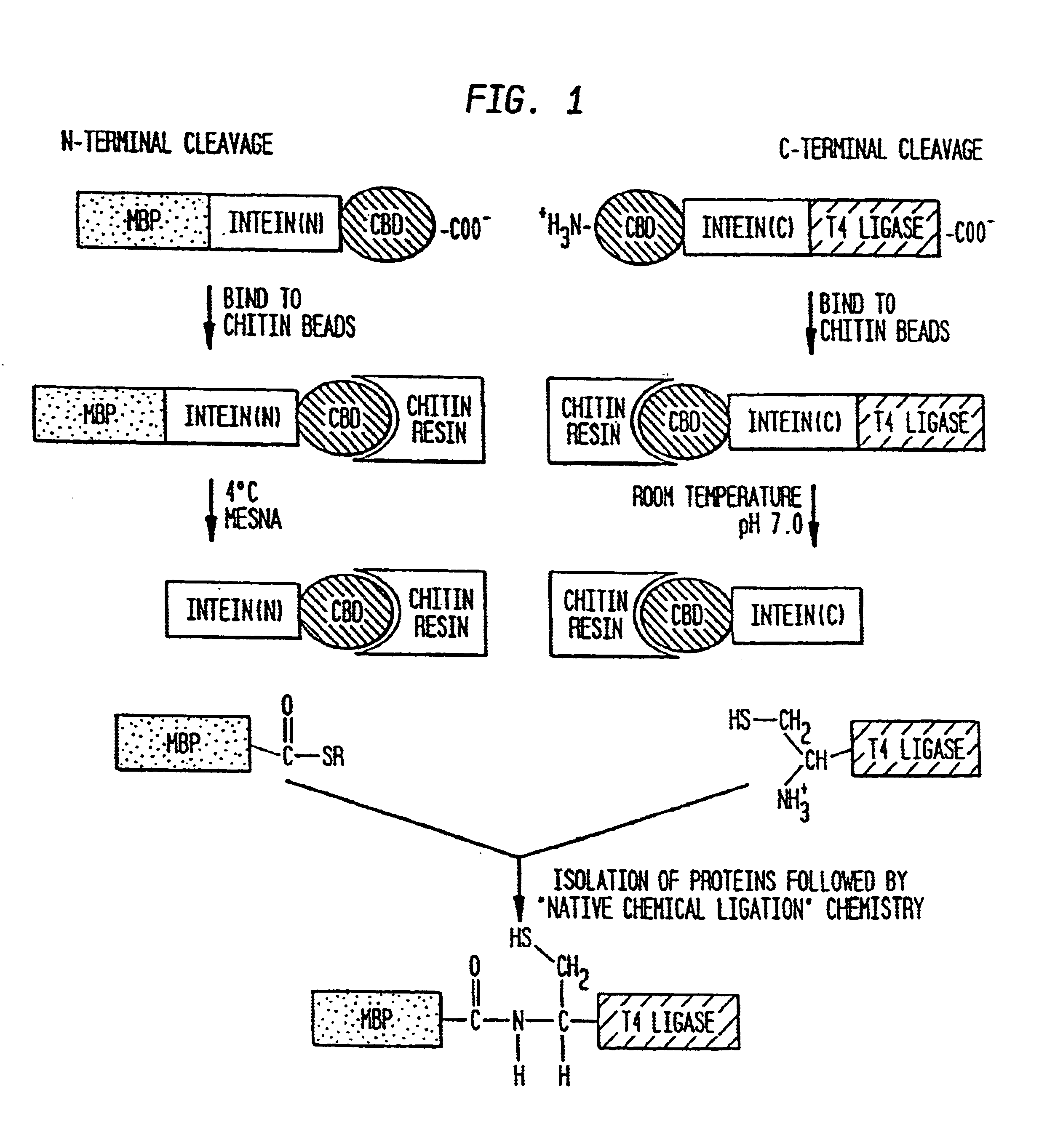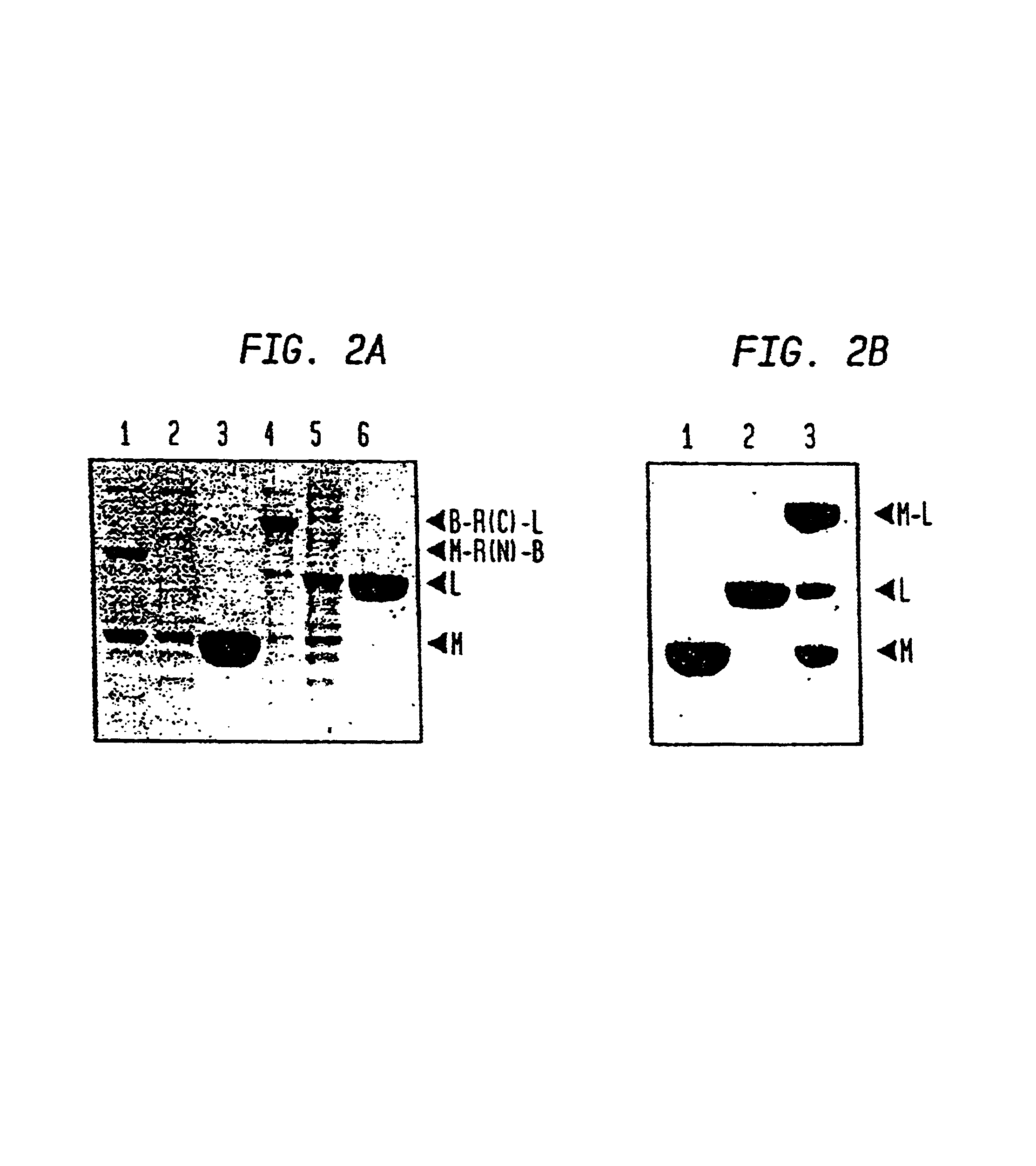Intein-mediated protein ligation of expressed proteins
a technology of intein-mediated protein ligation and expressed proteins, which is applied in the direction of polypeptides with his-tags, applications, peptides, etc., can solve the problems of multiple protease sites within a protein, limited general application of ipl, and the possibility of non-specific degradation
- Summary
- Abstract
- Description
- Claims
- Application Information
AI Technical Summary
Benefits of technology
Problems solved by technology
Method used
Image
Examples
example i
Creation of the Mth RIR1 Synthetic Gene
[0036]The gene encoding the Mth RIR1 intein along with 5 native N- and C-extein residues (Smith et al. supra (1997)) was constructed using 10 oligonucleotides (New England Biolabs, Beverly, Mass.) comprising both strands of the gene, as follows:[0037]1) 5′-TCGAGGCAACCAACCCCTGCGTATCCGGTGACACCATTGT AATGACTAGTGGCGGTCCGCGCACTGTGGCTGAACTGGAG GGCAAACCGTTCACCGCAC-3′ (SEQ ID NO:1)[0038]2) 5′-CCGGTTGGCTGCTCGCCACAGTTGTGTACAATGAAGCCAT TAGCAGTGAATGCGCTAGCACCGTAAACAGTAGCGTCATA AACATCCTGGCGG-3′ (SEQ ID NO:2)[0039]3) 5′-pTGATTCGCGGCTCTGGCTACCCATGCCCCTCAGGTTTCTT CCGCACCTGTGAACGTGACGTATATGATCTGCGTACACGT GAGGGTCATTGCTTACGTTT-3′ (SRQ ID NO:3)[0040]4) 5′-pGACCCATGATCACCGTGTTCTGGTGATGGATGGTGGCCTG GAATGGCGTGCCGCGGGTGAACTGGAACGCGGCGACCGCC TGGTGATGGATGATGCAGCT-3′ (SEQ ID NO:4)[0041]5) 5′-pGGCGAGTTTCCGGCACTGGCAACCTTCCGTGGCCTGCGTG GCGCTGGCCGCCAGGATGTTTATGACGCTACTGTTTTACGG TGCTAGC-3′ (SEQ ID NO:5)[0042]6) 5′-pGCATTCACTGCTAATGGCTTCATTGTACACAACTGTGGCG AGCAGCCAA-3′ (SEQ ID ...
example ii
Generating a Thioester-tagged Protein
[0050]The pMRB10G construct from Example I contains the Mth RIR1 intein engineered to undergo thiol reagent induced cleavage at the N-terminal splice junction (FIG. 1, N-terminal cleavage) and was used to isolate proteins with a C-terminal thioester as described previously for the Sce VMA and Mxe GyrA inteins (Chong et al. supra 1997); Evans et al., supra (1998)). Briefly, ER2566 cells (Evans et. al. (1998)) containing the appropriate plasmid were grown at 37° C. in LB 20 broth containing 100 μg / mL ampicillin to an OD600 of 0.5-0.6 followed by induction with IPTG (0.5 mM). Induction was either overnight at 15° C. or for 3 hours at 30° C.
[0051]The cells were pelleted by centrifugation at 3,000×g for 30 minutes followed by resuspension in buffer A (20 mM Tris-HCl, pH 7.5 containing 500 mM NaCl). The cell contents were released by sonication. Cell debris was removed by centrifugation at 23,000×g for 30 minutes and the supernatant was applied to a co...
example iii
Protein-protein Ligation using Intein-mediated Protein Ligation
[0055]Intein-mediated protein ligation (IPL) was used to fuse two proteins (FIG. 2B). Freshly isolated thioester-tagged protein from Example II was mixed with freshly isolated protein containing an N-terminal cysteine residue from Example II, with typical starting concentrations of 1-200 μM. The solution was concentrated with a Centriprep 3 or Centriprep 30 apparatus (Millipore Corporation, Bedford, Mass.) then with a Centricon 3 or Centricon 10 apparatus to a final concentration of 0.15-1.2 mM for each protein.
[0056]Ligation reactions proceeded overnight at 4° C. and were visualized using SDS-PAGE with 12% Tris-glycine gels (Novex Experimental Technology, San Diego, Calif.) stained with Coomassie Brilliant Blue. Typical ligation efficiencies ranged from 20-60%.
Confirmation of Ligation in IPL Reactions
[0057]A Factor Xa site in MBP that exists 5 amino acids N-terminal from the site of fusion (Maina et al, supra (1988)) al...
PUM
| Property | Measurement | Unit |
|---|---|---|
| temperature | aaaaa | aaaaa |
| pH | aaaaa | aaaaa |
| bed volume | aaaaa | aaaaa |
Abstract
Description
Claims
Application Information
 Login to View More
Login to View More - R&D
- Intellectual Property
- Life Sciences
- Materials
- Tech Scout
- Unparalleled Data Quality
- Higher Quality Content
- 60% Fewer Hallucinations
Browse by: Latest US Patents, China's latest patents, Technical Efficacy Thesaurus, Application Domain, Technology Topic, Popular Technical Reports.
© 2025 PatSnap. All rights reserved.Legal|Privacy policy|Modern Slavery Act Transparency Statement|Sitemap|About US| Contact US: help@patsnap.com



